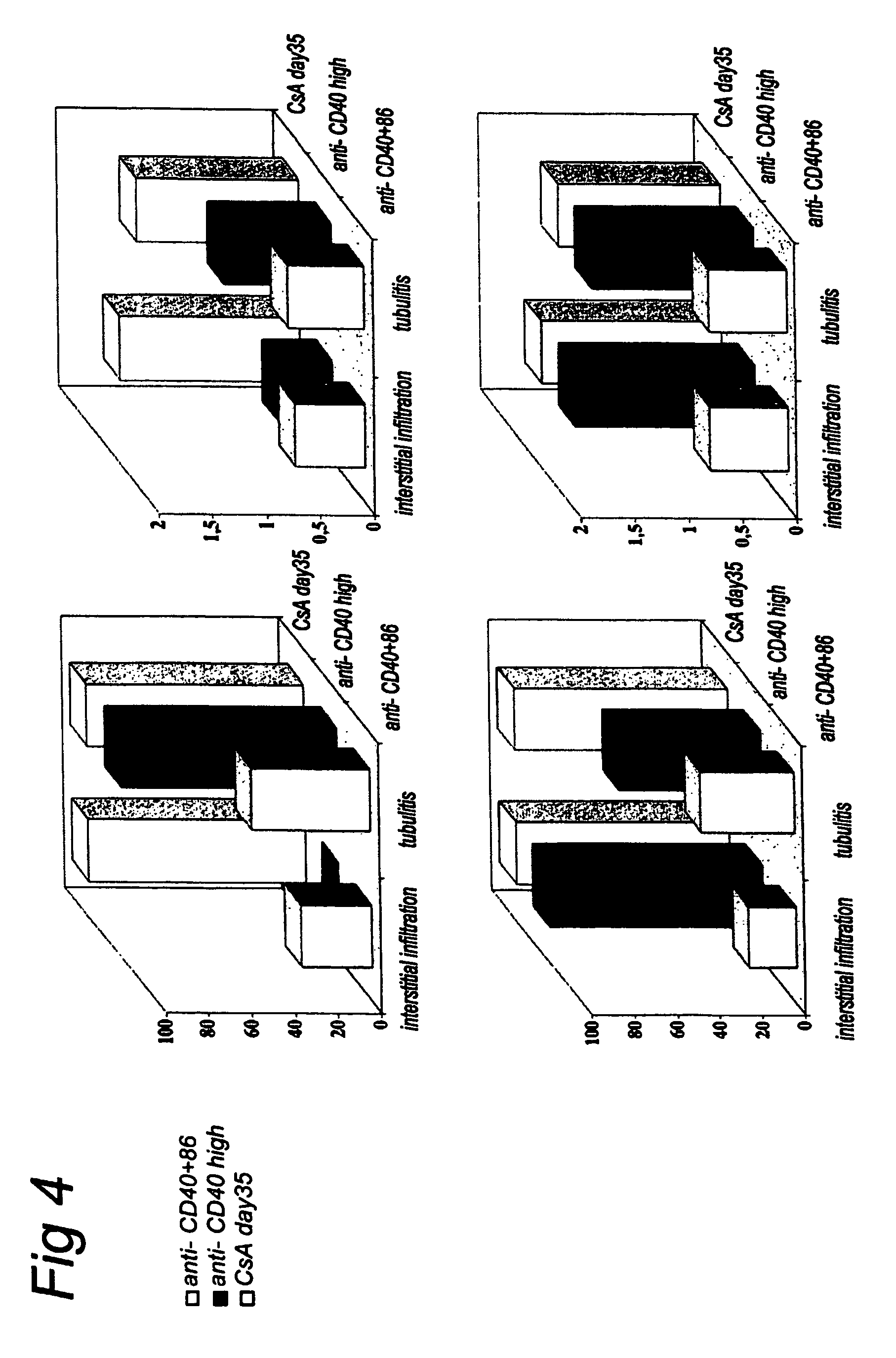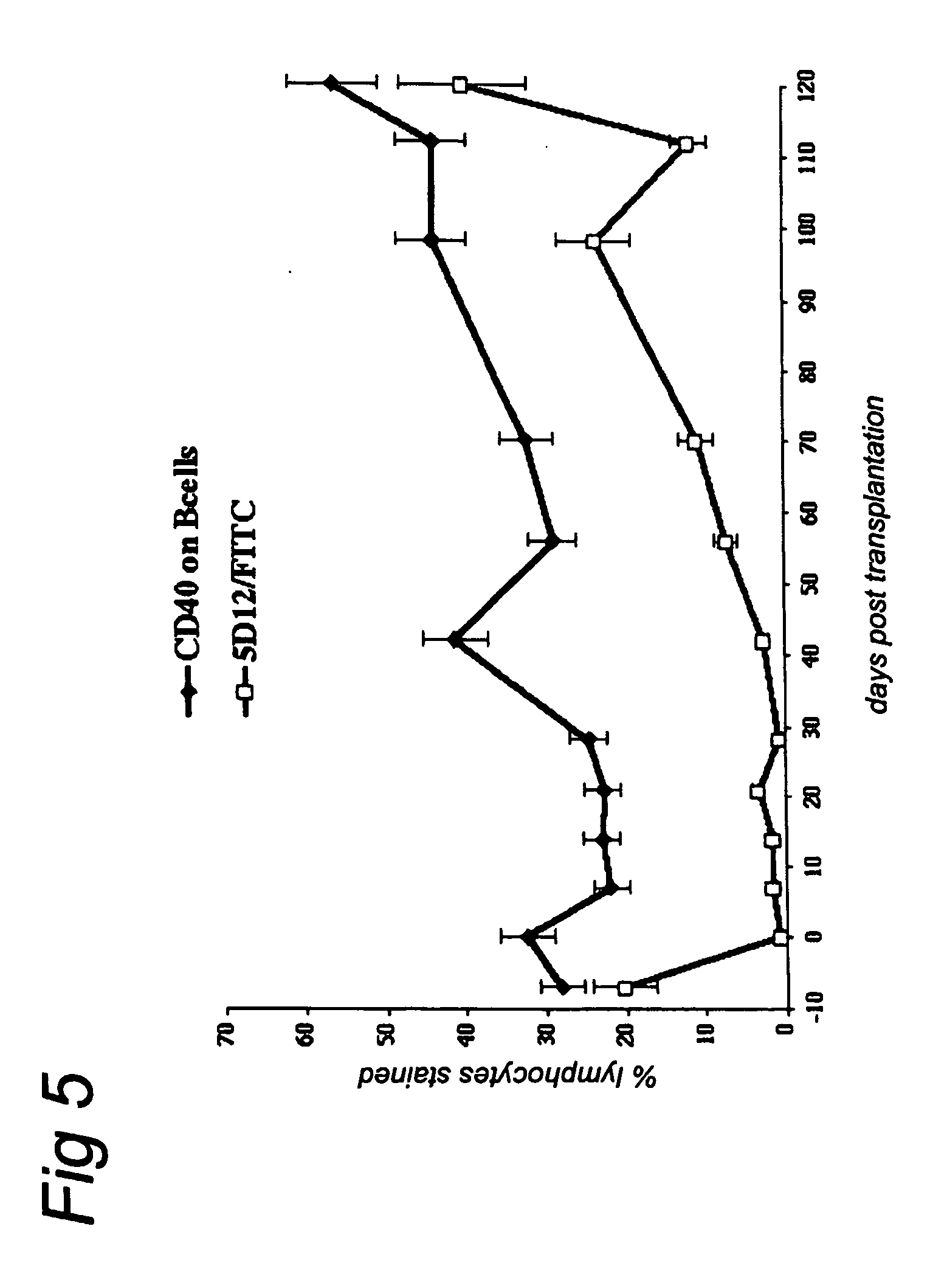Method of inducing immune tolerance
a technology of immune tolerance and induction method, which is applied in the direction of biocide, plant growth regulator, cyclic peptide ingredients, etc., can solve the problems of graft loss, t cell activation and costimulation, and achieve a similar effect, so as to inhibit t cell costimulation and induce t cell tolerance
- Summary
- Abstract
- Description
- Claims
- Application Information
AI Technical Summary
Benefits of technology
Problems solved by technology
Method used
Image
Examples
example 1
Onset of Graft Rejection
[0123] The serum creatinine and urea levels of each animal were monitored because they are the first parameters to rise when kidney function is impaired, thus serving as an early indicator of graft rejection (e.g., acute rejection). However, in the week immediately post transplantation serum creatinine and urea may also be elevated due to the transplantation procedure. When the rise in serum creatinine and urea is due to the transplant rejection, electrolytes also show abnormal values.
[0124] The results of this study are summarized in Table 2. The day at which the rejection process started was no different between groups 1a+b and groups 2a+b. However, it should be noted that in group 1a+b, which received anti-CD40 alone, some animals showed a short graft survival and others did not reject until several months after Mab treatment was stopped. Animals with a short graft survival which received a low dose of ch5D12 (BJG and 96087) did not show graft rejection ...
example 2
Pathology of Chronic Graft Rejection
[0127] As discussed herein, chronic rejection due to continuous immune activation and subsequent tissue damage is the major problem in current transplant medicine. For this reason, kidney biopsy specimens were also taken at several time points (e.g., days 21, 42, 70) for the animals in groups 1 and 2, and compared to control animals that were treated with CsA alone (10 mg / kg i.m. daily for 35 days).
[0128] As shown in Table 3 and FIG. 4, both infiltrate scores and tubulitis scores were reduced in animals treated with anti-CD40 or anti-CD40+anti-CD86 when compared to the CsA treated controls. Moreover, on biopsies from days 21 and 42, less interstitial infiltration or tubulitis was present in animals treated with the combination of Mabs than in animals treated with ch5D12 alone. Thus, it seems that the combination of Mabs prevented graft infiltration. However, it is also possible that the infiltrating cells seen in the animals treated with ch5D12 ...
example 3
Graft Pathology after Euthanasia
[0129] Animals were euthanized before they became clinically ill due to the rejection process, and pathology was performed to determine the extent of tissue rejection. A comparison of the Banff scores for each animal is summarized in Table 3.
[0130] Of the seven animals treated with anti-CD40 alone (group 1), three rejected the transplant while still on treatment. Two of these animals received the lower dose of anti-CD40 (group 1a). One animal died after 12 days due to a blocked ureter and had only borderline signs of rejection, and the remaining three animals did not reject their graft during treatment, but at variable times after cessation of treatment.
[0131] None of the animals treated with the combination of anti-CD40 and anti-CD86 showed signs of graft rejection during treatment (group 2). However all animals rejected the kidney transplant around the end of the treatment period. Only one animal had only borderline signs of kidney rejection, but...
PUM
| Property | Measurement | Unit |
|---|---|---|
| Time | aaaaa | aaaaa |
| Time | aaaaa | aaaaa |
| Time | aaaaa | aaaaa |
Abstract
Description
Claims
Application Information
 Login to View More
Login to View More - R&D
- Intellectual Property
- Life Sciences
- Materials
- Tech Scout
- Unparalleled Data Quality
- Higher Quality Content
- 60% Fewer Hallucinations
Browse by: Latest US Patents, China's latest patents, Technical Efficacy Thesaurus, Application Domain, Technology Topic, Popular Technical Reports.
© 2025 PatSnap. All rights reserved.Legal|Privacy policy|Modern Slavery Act Transparency Statement|Sitemap|About US| Contact US: help@patsnap.com



